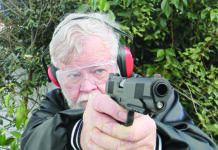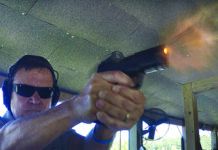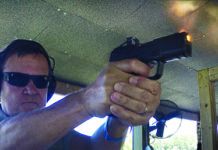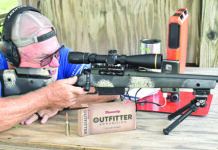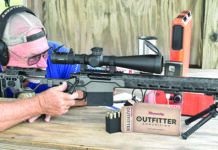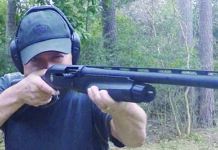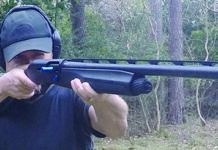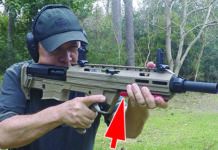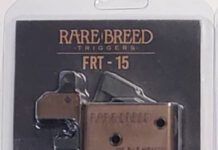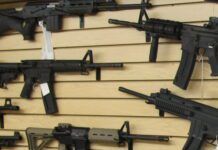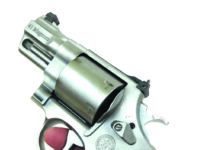Re “A Trio OF M14s: Springfield, Fulton
Armory, Polytech Custom,” December 2010
I gathered from your article on M14s that the Springfield M1A functioned fine with either 168-gr Federal Gold Medal Match or 150-gr Magtech. I checked their owners manuals and the M1A is chambered for 7.62. My M1A will not function correctly with Remington Core-Lokt ammunition. I found some Winchester 7.62 and was hoping that it would function correctly with it. Your thoughts? —Mark O’Brien
Mr. O’Brien, you are courting disaster with the use of lead-tipped bullets, or most other types of soft-nose ammunition in your gas gun. I quote from The M14 Owner’s Guide by Scott Duff & Mohn Miller: “Lead nosed, soft point, blunt nosed and some hunting-type hollow point bullets will not feed reliably. Such bullets can be a safety hazard. Bits of soft … bullet material can be shaved off and the particle can lodge in the chamber causing the bolt to close improperly. Pulling the trigger while the bolt is out of battery results in CATASTROPHIC FAILURE. [My emphasis]. Always use FMJ bullets.” The book adds, “For hunting, try Nosler Ballistic Tips…. The tip of the bullet is made of polycarbonate plastic. It is very strong, will not chip, and feeds well.” —Ray Ordorica
I was just downstairs reloading 308 and remembered that I wanted to write regarding your three-gun test of M14s/M1As in the December issue. I have a Springfield Armory M1A that I have put close to 3000 rounds of various ammo through, reloads plus South African, Indian, and Aussie surplus, and it’s always functioned very well. I too have the brass bits after shooting it, but have not seen any ill effects on either the gun or the brass, some of which I have reloaded a half-dozen times.
As I remember, I purchased mine from Springfield, as I had seen bad reviews of the Chinese copies and thought that the Fulton guns were a little expensive. I have not been disappointed in mine and use it regularly for club military position matches. All that said, I also have two Fulton Armory rebuilt Garands, and they are beautiful and have very good accuracy—better than I can shoot them!
Keep up the good work. —Dave Mahle
I enjoyed your article comparing the three different M14 offerings from Springfield, Fulton Armory, and Polytech. I am curious as to why you didn’t use Springfield’s National Match model, which has several accuracy enhancements and is more closely priced to the other models in the test. That would, IMHO, create a more level playing field in terms of an accuracy/value comparison.
—John Sanders,
Ridgeland, Mississippi
Just dropping a note, It’s hard to judge where you are coming from, to use the vernacular. I cannot see any reason why the test would pit a $2700 rifle against another one $1000 less? Obviously, the more costly one is “customized,” thus rendering the test invalid and useless, in my opinion. —Phil
I was somewhat disappointed in the selection of the standard-grade Springfield Armory M1A in a heads-up test against a $2700 Fulton Armory M14 308 and a $1900 custom Polytech M14S in the December 2010 issue. I would think that the Springfield Armory National Match or the Loaded model would have been a better match in price range, accuracy, and possibly, the fitment issues you described. Your test crew indicated that improvement in the Fulton was worth $1000 more. How much better would the Springfield have been at a few hundred more for a upgraded model? The playing field was not level on this one. —Walter
We looked to see how many M14-type rifles were out there—not that many—and chose to pit the very few and most popular choices against each other to give the reader a good look at why one costs so much more than the other, with a third alternative from an occasionally still-available third maker that shows what can be done with one of these rifles. The Fulton is not “customized.” It’s assembled with a great deal of care, but it is essentially a production rifle, just as is the M1A. We had no intent of making this an equal-price matchup. Rather, we chose to test the least costly rifle by Springfield, find out what an extra $1000 can buy for Fulton’s lowest-cost rifle, and then show you what an outstanding rifle you can have if you upgrade a low-priced Chinese version. As we found, all were excellent. We could test a more costly Springfield, but it would only be fair to test it against a higher-grade Fulton. —RayO
Re “Four M1 Carbines: CMP, Fulton, And
Auto-Ordnance Compete,” December 2009
Based on Ray’s article about CMP carbines last year, I ordered one this past May for $495. I received an Underwood made in 1943 that had been put through an arsenal sometime thereafter, as it had a stamped adjustable rear sight, bayonet lug, etc. It wasn’t beautiful, but it was all there. It was one of the machined push-button-safety types. It was completely Underwood, however, with no mismatched manufacturer parts. What impressed me the most was how accurate the old girl was after all these years. The bore was bright and shiny. Groups were nice and tight. The bad news is that all the carbines are gone, and there ain’t no more. All that remains are the German police versions, and those through auction only.
—Bernie Urbanik
Plano, Texas
Re “Guns of the Year,” December 2010
I was curious why 40-caliber ammunition was not discussed along with 45 and 9mm. Since this is what I am thinking about, any info would be helpful.
—J.B.
Westminster, Colorado
No mystery—we didn’t test 40 S&W ammo during 2010. Bob Campbell has a full slate of ammo tests coming up, but I don’t think 40s are in the mix yet. We’ll talk it over. —Todd Woodard
Re “Downrange,” December 2010
I have to question the following line in your December editorial: “And in Wisconsin, Ron Johnson (R) defeated gun-hating incumbent Russ Feingold (D).”
I would not call the one who voted against the assault weapon ban in ‘04, voted in favor of allowing airline pilots to carry firearms in the cockpit in ‘02, and had always been against any handgun bans or mandatory firearms registration, as gun-hating.
I might, however, question the sincerity of a slick millionaire executive who originally said he had no problem with some type of gun-registration program, and later retracted it when he realized just exactly what that meant to his desired supporters.
—Pete Williams,
Wisconsin
From Richard Moore, a reporter at the Lakeland Times (Minocqua, Wis.) on Oct. 26: “In the U.S. Senate race, the NRA is solidly in the camp of Republican Ron Johnson, who is challenging incumbent Democratic Sen. Russ Feingold. The organization gave Johnson an ‘A’ rating based on his survey, while it tagged Feingold with a ‘C’ based on his record. The NRA says Johnson has committed to supporting pro-gun reforms and opposing all federal gun control restrictions, and opposes the licensing and registration of firearms. In addition, Johnson backs a shall-issue right-to-carry law in Wisconsin.… Over the years Feingold’s NRA rating has improved, from a ‘F’ in 1998 to a ‘D’ in 2004 to a ‘C’ this year.” So, I’ll grant that “hating” might have been a notch too strong, but Feingold didn’t consistently vote gun owners’ way until this year. —tw
Re “Rimfire Riflescopes Under $50:
Bubbles Sink TruGlo and BSA,” December 2010
I have mostly agreed with your articles over the past several years, but you threw me for a loop with the rimfire riflescopes under $50 article. I’m not sure I would hunt anything in -4 degree weather, especially with a 22. Nor have I ever had the need to use my scope for a hammer or shoot any of my guns underwater. Instead of telling us which scopes were a bargain for use under reasonably average shooting conditions, we now know which ones not to take to the North Pole for scuba diving and bludgeoning renegade penguins. Hope your spell of destructive tendencies has passed, and you enjoy a great Christmas season.
—Harold Schott
La Vernia, Texas
But for the same money, why not buy the inexpensive scope that won’t fog? Anyway, these are much the same optics protocols we’ve used since 1998, with the addition of impact testing. Before adding that hurdle, Robert Sadowski surveyed various companies to see how much abuse was fair—and no penguins were harmed in the execution of the test. —tw
Thanks for all the great info recently on ammo for 380 pistols. I own a number of great carry pistols by Sig (9mm P239 and P228), Glock (40 S&W G27), and S&W (Model 638, 38 Sp. Bodyguard), but the one that is easiest to carry and the one I carry the most is my Kel-Tec P3AT in 380 Auto. I often load my two or three mags with a combo of your highly rated Speer Gold Dot #23606 hollowpoints, as well as a variety of FMJ ammo, plus frangibles. I’m not sure if I missed the review, but I don’t remember any recent articles about ammo for the 380 including rounds like the Glaser Safety Slug in addition to your previous recommendations?
Glaser, as I’m sure you know, is made by Cor-Bon, and was made famous as the round used by Federal Air Marshalls flying undercover aboard U.S. airliners. I like it in my arsenal since I’m in Arizona, and rarely have to be concerned about penetration through heavy clothing. The Glaser advertises great stopping power as well as not penetrating the skin of Boeing 737s. Your thoughts?
—Don Jensen,
Tucson, Arizona
In an overall sense, Bob Campbell was worried about recommending any of the 380s because of their lack of penetration, and the Glasers are suited to the cabin of an airplane because of the possibility of misses, not because of shoot-throughs. But in some environments, they seem to make sense. At some point, we’ll get a chance to see how they do head to head against some 380s we like. —tw
Re “7.62x39mm Semiautos: Three Alternatives
to the AR-15 Rifle,” July 2010
This article drew great interest from me. I own a Soviet made pre-Clinton ban SKS. I paid about $200 for my SKS in the early 1990s. Until the ban, it never even occurred to me to own an SKS or AK-47. After I bought the little carbine, however, I quickly realized what a flat-shooting firearm it was for out of the box at 100 yards with battle sights. I have often wondered since how it compared with more expensive rifles. Your publication made this possible, thank you.
According to The SKS Carbine by Steve Kehaya and Joe Poyer, development of the “7.62x39mm round began in 1939 and was perfected in 1943. Well before the AK-47, which fires the same round, the SKS preceded the AK-47 by several years.” At the time of the publication of their book, the SKS carbine is still being used by the Russian Ceremonial Guards. This is quite an honor to the little carbine, I would suggest.
In your piece, the SKS was compared to the more expensive Ruger K-Mini, and the DPMS Panther. The more expensive weapons wouldn’t consistently fire the Wolf 124-grain bullet. My question is, why delete the cartridge rather than just giving the two more expensive rifles a grade lower than a B+, while giving the SKS only a B? Though on the range the misfires may not be that big a deal, lined up on game in the woods, however, is another story. I have never experienced a misfire with my SKS that I can remember. Also apart from surplus military FMJ, I have found the Wolf brand to be inexpensive while also available in the hollowpoint, which is required in many states to hunt game. It is pretty much all I use. Apparently, the SKS shares similar ballistics with the venerable 30-30, according to Kehaya and Poyer.
As you pointed out, the Type 56 is a battle rifle and subject to the rigors of the battlefield. What I would like to point out is that due to its low production costs, it has always been an inexpensive, often disposable frontline battle rifle which found its way more times than not into untrained hands. When compared to the AK-47 or even moreso our faithful, expensive M16 or AR-15, the SKS is downright cheap. When compared to more expensive firearms using the 7.62x39mm, apparently the SKS holds its own.
Yes, there are a ton of cool, inexpensive accessories for these guns. In the hands of the willing sportsman, the SKS Type-56 can be modified into a carbine that is a sweetheart at the range. More important, it is reliable in the woods. I realize there are other types of SKS out there that supercede mine in performance. However, the fact that mine is Soviet made and not Chinese places credit where credit is due.
I can’t help but feel a little pride that I made the decision to purchase one of these little carbines back when it wasn’t cool to own one. And I’m pleased that the Type-56 did so well when compared to two rifles costing so much more. It is one of my favorite guns.
—David Mangano,
Elkton, Maryland



